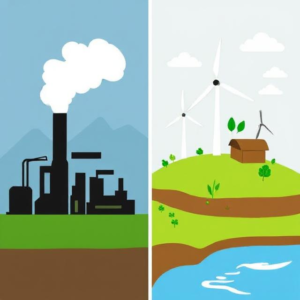Conventional Sources of Energy
Conventional energy sources are those that are widely used but often non-renewable and polluting. Here’s a breakdown of the most common conventional sources:
Coal:
- How it works: Coal is burned to produce heat, which turns water into steam. The steam drives a turbine to produce electricity.
- Advantages: It’s abundant and cheap.
- Disadvantages: It creates a lot of pollution and greenhouse gases, contributing to climate change.
Oil:
- How it works: Oil is refined to produce fuels like gasoline and diesel. These fuels are used for transportation and also in power plants to generate electricity.
- Advantages: It is easy to transport and widely used for transportation.
- Disadvantages: Burning oil releases harmful gases that pollute the air and contribute to global warming. It’s also a non-renewable resource.
Natural Gas:
- How it works: Natural gas is burned to produce heat, which is used to generate electricity or for heating and cooking in homes.
- Advantages: It burns cleaner than coal and oil, producing less pollution.
- Disadvantages: Like oil and coal, it is a fossil fuel and is non-renewable. It still contributes to pollution and global warming.

Non-conventional Sources of Energy
These are newer, renewable, and cleaner energy sources that are more environmentally friendly. They don’t deplete over time and have a smaller negative impact on the environment.
- In simple terms: Non-conventional energy sources are renewable and cleaner. They are better for the planet and don’t run out as easily.
Examples:
- Solar Energy: Energy from the sun, captured using solar panels.
- Wind Energy: Energy from wind, captured using wind turbines.
- Hydropower: Energy from flowing water (like rivers or dams).
- Biomass: Energy from organic materials, like plants or animal waste.
- Geothermal Energy: Energy from heat inside the Earth.
Summary:
- Conventional Sources (like coal, oil, and natural gas) are widely used but have environmental downsides.
- Non-Conventional Sources (like solar, wind, and geothermal) are cleaner, renewable, and better for the environment.
Tags: abundant, air pollution, alternative energy, biomass, carbon emissions, cheap, clean energy, combustion, Conventional Sources of Energy, Conventional Sources of Energy: coal, dams, Earth’s heat, eco-friendly, electricity generation, energy crisis. Non-Conventional Sources of Energy: solar energy, environmentally friendly, fossil fuels, future energy solutions., Geothermal energy, Global Warming, Green energy, greenhouse gases, heating, hydropower, limited supply, low pollution, natural gas, non-renewable, oil, organic waste, pollution, power plants, renewable, solar panels, steam turbines, sustainable, transportation fuel, unlimited resource, wind energy, wind turbines


